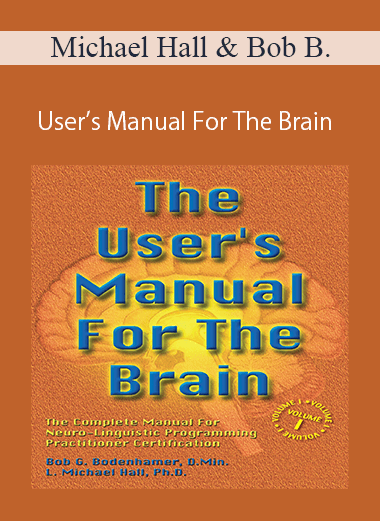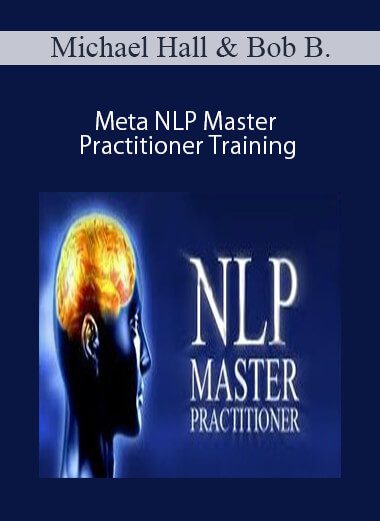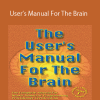Michael Hall & Bob Bodenhamer – User’s Manual For The Brain
$25.00 Original price was: $25.00.$10.00Current price is: $10.00.
Digital Download: You will receive a download link via your order email after successful payment.
L. Michael Hall, Ph.D. says concerning this manual, “Dr. Bob Bodenhamer developed this manual for Running Your Own Brain over a seven year period as he taught NLP for Adult Education at Gaston College and conducted NLP Practitioner Certification training. From those practical contexts, he developed this manual to give people new to NLP a clear and understandable presentation.
User’s Manual For The Brain
The Complete Manual for
Neuro-Linguistic Programming Practitioner Certification
by
Bobby G. Bodenhamer, D.Min.
L. Michael Hall, Ph.D.
L. Michael Hall, Ph.D. says concerning this manual, “Dr. Bob Bodenhamer developed this manual for Running Your Own Brain over a seven year period as he taught NLP for Adult Education at Gaston College and conducted NLP Practitioner Certification training. From those practical contexts, he developed this manual to give people new to NLP a clear and understandable presentation.
Reviewers have noted this by saying, ‘Readable, practical — presents the heart and soul of NLP.’ Part of what makes this work so readable includes: the ‘text boxes’ that emphasizes key point, introductions for each chapter, discussion questions at the end of each chapter, an extensive bibliography and glossary,
Here you will find NLP sequentially presented so that each section builds on the previous one. With a mixture of presentation, example, thought experiments, case studies, outlines, metaphors, etc. the manual trains both conscious and unconscious minds. For trainers, overhead mats of the material are available.
Cutting-Edge Material: This manual further includes the latest discoveries about submodalities and the Meta-States Model. No other manual anywhere incorporates these two items.”
I (BB) believe that the reader will find within these 400 plus pages the single most understandable and readable treatment of basic NLP available today. Because it has come out of seven years of actual training sessions of NLP, many of your questions will find answers. All techniques have exercises that follow to lead to behaviorial integration of the materials.
Table of Contents
How to Use This Manual
Introduction
The Study of Excellence
The Experiential Nature of NLP
Formal Definition of NLP
Part 1: The NLP Model and Techniques
Chapter 1 – The Content of the Model: The Representational System
The Representational System Preference Test
Representational System Practice
Predicates and Process Words
Predicate List
Matching Predicate Exercise
Eye Accessing Cues
Eye Position Chart
Lead System
Mapping Eye Patterns Exercises
Characteristics of The Primary Rep System
- Submodalities-The Sub-Qualities of the Modalities
Chapter 2 – Connecting With People: Building and Maintaining Rapport
Sensory Acuity
Direction for Group Work
Sensory Acuity Exercise
How to Gain Rapport: Matching & Mirroring
Mirroring Exercises
Difference Between Matching & Mirroring
Matching and Mirroring an Angry Person
Knowing When You Have Rapport
Chapter 3 – Perceptual Positions
The Fourth Perceptual Position
The Fifth Perceptual Position
Perceptual Positions Exercise
Aligning Perceptual Positions
Chapter 4 – NLP Presupposition For Building Resourcefulness
Keeping the Context in Mind
NLP’s Theoretical Assumptive Presuppostions
The NLP Presuppositional Beliefs
Mental Processing Presuppositions
The map is not the territory.
People respond according to their maps.
Meaning operates context dependently.
Mind-and-body inevitably & inescapably affect each other.
Individual skills function by developing & sequencing representational system.
- Strategies
We respect the person’s model of the world.
Presuppositions about human behavior/responses.
Person & behavior describe different phenomena.
Every behavior has utility and usefulness–in some context.
We evaluate behavior & change in terms of context & ecology.
Communicational Presuppositions
We cannot not communicate.
The way we communicate affects perception & reception.
The meaning of your communication lies in the response you get.
The one who sets the frame for the communication controls the communicating.
There is no failure, only feedback.
The person with the most flexibility controls things.
Resistance indicates the lack of rapport.
Learning–Choice–Change Presuppositions
People have the internal resources they need to succeed.
All communication should increase choice.
People make the best choices open to them when they act.
As response-able persons, we can run our brains & control our results.
Chapter 5 – NLP as a Communication Model: Excellence in Communicating
Three Qualities of Exceptional Communicators
Well-Formed Outcome Model
- Stated Positively
- Described in Sensory-Based Language
- Self Initiated and Controlled
- Appropriately Contextualized
- Maintain Appropriate Secondary Gain
- Build in Needed Resources
- Ecological for the Whole System
- Cartesian Coordinates
- Additional Questions
- Well-Formed Outcome Exercises
- Overview of the NLP Communication Model
- Facets of Communication
- Communication Dimensions
Chapter 6 – Framing for Resourcefulness
Part I – Using Different Frames of Reference
- Backtrack Frame
- “As If” Frame
- The “Agreement” Frame
Part II – Dissociative Frame for Handling Criticism
Part III – Dissociative Frame for Phobias and Trauma
- Fast-Phobia Cure Simplified
- Other Editing Tools
Chapter 7 – The Art of State Management
1st State Understanding
2nd State Awareness
3rd State Alteration
4th State Utilization
The Pattern
The Skill of Elicitation
Part II: The NLP Language Model
Chapter 8 – The Meta-Model of Language
Deep Structure/Surface Structure
Deletions
Distortions
Generalizations
Distortions
Nominalization
Mind Reading
Cause-Effect
Complex Equivalence
Presuppositions
Generalizations
Universal Quantifiers
Modal Operators
Lost Performative
Deletions
Simple Deletions
Comparative Deletions
Lack of Referential Index
Unspecified Verb
The Meta-Model of Language Chart
The Extended Meta-Model
Identity/Identification (Id.)
Static Words (Signal Words, SW)
Over/ Under Defined Terms (O/U)
Delusional Verbal Splits (DVS)
Pseudo-Words (PW)
Multi-Ordinality (MO)
Personalizing
Metaphor/Metaphoring
The MM of Language-Extended Chart
Linguistics Today
Chapter 9 – Hypnosis-Part I – The Misunderstood Nature of So-Called “Hypnosis”
Defining Hypnosis
The Conscious/Unconscious Mind
Altered States and Trance
Trancing Ourselves to Face the Inner Darkness
The Feeling of Trance
“Hypnosis” As Poetry
The Six-Step Reframe Extended
So How Does “Hypnosis” Work?
Chapter 10 – Hypnosis – Part II – The Milton Model
Tag Questions
Pacing Current Experience
Double Binds
Conversational Postulate
Extended Quotes
Selectional Restriction Violation
Phonological Ambiguities
Syntactic Ambiguity179
Scope Ambiguity
Punctuation Ambiguity
Utilization
Embedded Commands
Analogue Marking
Linkage Language
Conjunctions
Disjunction
Adverbial Clause or Implied Causatives
Summary Page of Milton Model Language
Steps In Communicating
Chapter 11 – Hypnosis – Part III – Storying, Metaphor, Analogy
Transderivational Searches
Displacing Referential Indexes
Isomorphism
Transforming Meaning Using Metaphor
Connecting Present State with Desired State
- Pacing
- Leading
Utilizing Reframing within Metaphors
Unspecified Verbs, Nominalizations, Embedded Commands & Analogue Marking
- Unspecified Verbs
- Nominalizations
- Embedded Commands
The Attractiveness of Metaphors
Boiler Factor Metaphor
Metaphor Analysis
Constructing a Metaphor
The Basics Steps in Generating a Metaphor
Metaphor Exercises
- Building Associations
- Likeness
- Therapeutic Metaphor
Chapter 12 – Satir Categories: Adding Variety to your Communication
The Categories
Exercise
Example of Replies
Satir Categories in Public Speaking
Part III: The NLP Neurology Model
Chapter 13 – Anchoring: Managing Neurology
The Stimulus-Response Concept
What do we mean by “An Anchor?”
Warning: “Negative Anchors Present”
Anchoring Forgiveness
Consciously Anchoring in Therapy
Developing the Art of Anchoring Effectively
Four Keys to Anchoring
- Uniqueness
- State Intensity
- Purity
- Precision
Five Steps to Anchoring
- Establish Rapport
- Explain the Process
- Elicit and Anchor the Desired Response
- Break State
- Test
Exercises
- Anchoring States 1
- Anchoring States 2
- Transderivational Search (TDS)
- TDS and Limiting Feelings
- Uptime Self-Anchor
- Intime Self-Anchor
- Circle of Excellence
- Collapsing Anchors: Integrating Parts
- Change Personal History
- Change Personal History Through the Eyes of The Meta-States Model
- Collapsing Visual Anchors: Overcoming Doubt
- Chaining Anchors
- Stage Anchoring
- The Visual Squash Pattern
Chapter 14 – Introduction to Submodalities
Submodality Checklist
Therapeutic Interventions Using Submodalities
SBMD Exploration Exercise
- “The Cure” for Headaches and Other Uncomfortable Feelings
- Mapping Across with SBMD
- Time Line SBMD endspan -->How Your Brain Tells Time
- Time Line SBMD Exercise
- Godiva Chocolate Pattern
- The Swish Pattern
- Belief Formation Change Pattern
- Grief/Loss Pattern
Part IV: Advanced Neuro-Linguistic Programming
Chapter 15 – Strategies – Part 1 – Identifying the Pieces of Subjectivity
NLP — A Model of Models
The Philosophy/Epistemology of NLP
The Components of Subjectivity
Map-Making: Creating Maps for Charting Territory
- Deletion
- Generalization
- Distortion
Modeling that Creates Strategy Maps
Strategies – Part 2 – The NLP Strategy Model
- “Once Upon a Time There Was a Stimulus- Response Model . . .”
- “And then the S-R Grew Up Into a T.O.T.E.”
- NLP Enriched the TOTE and Created “Strategies”
- Mastering “The Strategy Model”
- Strategy Elicitation
- Unpacking Strategies as They Zoom By
- Designing Strategies
- Designing New and Better Strategies
- Utilizing Strategies
- Installation of Strategies
- New Distinctions
Strategies – Part 3 – More on Strategies
- Strategy Elicitation
- Eliciting Decision Strategies
- Strategy Elicitation through Backtracking
- Potential Problems with Decision Strategy
- Pointers in Elicitation
- Exercises
- The Spelling Strategy
- Decision Strategy
- Motivation Strategy
- Learning Strategy
Chapter 16 – An Introduction to The Techniques of Time Line Therapy™
Anglo-European and Arabic Time
Difficulty Eliciting the Time Line
Parts Reframe
Through Time and In Time
Developmental Periods
- Imprint Period
- Modeling Period
- Socialization Period
Presenting Problem
Memory Management: Experiencing Your Time Line
Deleting Memories with the Fast Phobia Cure
Replacing Memories with the Swish Pattern
Steps Into The Techniques of Time Line Therapy™
- Establish Rapport
- Gathering Information
- Going From Effect to Cause
- Dissociate From the Problem
- Scramble the Strategy
- Discover the Root Cause
Letting Go of Negative Emotions: Using The Techniques of Time Line Therapy™
- Experiencing Your Time Line: Letting Go of Negative Emotions
- When the Emotions Won’t Let Go
- When the Emotions Haven’t Disappeared During Testing
Bibliography
Glossary of Terms
Overhead Mats for the NLP Trainer
Get download Michael Hall & Bob Bodenhamer – User’s Manual For The Brain at IMC.sale today!
Delivery Method
– After your purchase, you’ll see a View your orders link which goes to the Downloads page. Here, you can download all the files associated with your order.
– Downloads are available once your payment is confirmed, we’ll also send you a download notification email separate from any transaction notification emails you receive from IMC.sale.
– Since it is a digital copy, our suggestion is to download and save it to your hard drive. In case the link is broken for any reason, please contact us and we will resend the new download link.
– If you cannot find the download link, please don’t worry about that. We will update and notify you as soon as possible at 8:00 AM – 8:00 PM (UTC+8).
Thank You For Shopping With Us!






5 reviews for Michael Hall & Bob Bodenhamer – User’s Manual For The Brain
There are no reviews yet.